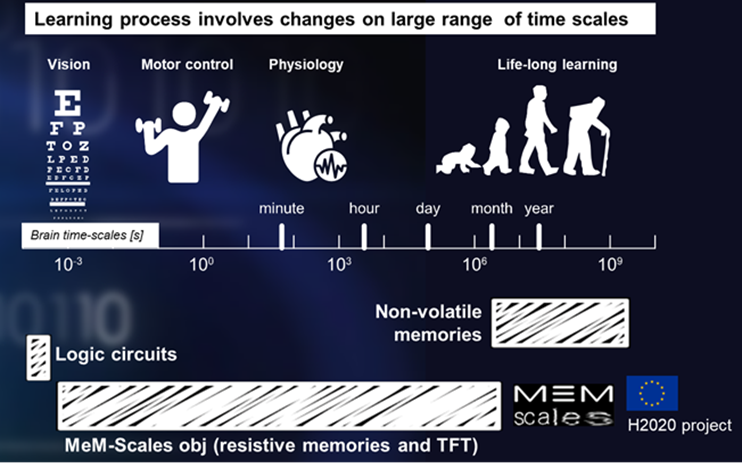EU Project to Mimic Multi-Timescale Processing of Biological Neural Systems

CEA-Leti has announced the launch of an EU project to develop a novel class of algorithms, devices and circuits that reproduce multi-timescale processing of biological neural systems. The results will be used to build neuromorphic computing systems that can process efficiently real-world sensory signals and natural time-series data in real-time and to demonstrate this with a practical laboratory prototype.
The technology developed in the MeM-Scales project will enable novel solutions for the Internet of Things (IoT). In the future IoT, much computing volume will be offloaded from central servers and delegated to small controllers and intelligent sensors directly where their services are needed. These IoT systems must be able to work reliably, without interruptions and with very low energy demands. The project also will develop edge-computing processing systems for applications that do not require connectivity to the cloud.
Multi-timescale processing is inspired by neural processing in the nervous system, which occurs naturally over time scales ranging from milliseconds (axonal transmission) to seconds (spoken phrases) and much longer intervals (motor learning).
“The MeM-Scales project aims at lifting neuromorphic computing in analog spiking microprocessors to an entirely new level of performance,” said Elisa Vianello, manager of CEA-Leti’s AI program and the coordinator of the MeM-Scales project. “Our work is based on a dedicated commitment that novel hardware and novel computational concepts must co-evolve in a close interaction between nano-electronic device engineering, circuit-and-microprocessor design, fabrication technology and computing science: machine learning and nonlinear modeling.”
For physical substrates, novel memory and device technologies will be fabricated to support on-chip learning over multiple timescales for both synapses and neurons. Multi-timescale resistive memory technologies as well as thin-film transistor (TFT) technology will be used to enable timescales spanning up to nine orders of magnitude. On the side of computational theory, autonomous learning algorithms and architectures supporting computation over this wide range of timescales will be developed. These computational methods will be specifically tailored to cope with the low numerical precision, parameter drift, stochasticity and device mismatch that are inherent in analog nanoscale devices.
“These cross-disciplinary efforts will lead to the fabrication of an innovative hardware/software platform as a basis for future products combining extreme power efficiency with robust cognitive computing capabilities,” Vianello said. “This new kind of computing technology will open new perspectives; for instance, for high-dimensional distributed environmental monitoring, implantable medical-diagnostic microchips, wearable electronics and human-computer interfaces.”
The project brings together European specialists in neuromorphic engineering, an emerging interdisciplinary field that takes inspiration from biology, physics, mathematics, computer science, and engineering to design hardware/physical models of neural and sensory systems. The project’s name is short for Memory technologies with Multi-Scale time constants for neuromorphic architectures.
In addition to CEA-Leti, members include:
| Imec | Interuniversitair Micro-Electronica Centrum | Belgium |
| Imec-NL | Stichting IMEC Nederland | Netherlands |
| IBM | IBM Research Gmbh | Switzerland |
| UZH | University of Zurich | Switzerland |
| CSIS | Consejo superior de Investigaciones Científicas | Spain |
| CNR | Consiglio Nazionale delle Ricerche | Italy |
| SynSense | Switzerland | |
| UOG | Rijksuniversiteit Groningen | Netherlands |

































